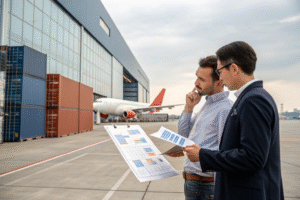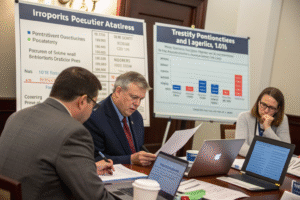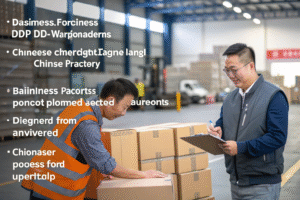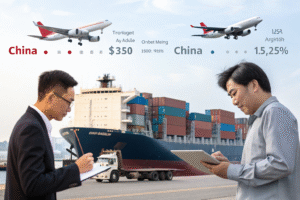Damage in transit is one of the most expensive hidden costs in global trade. As a logistics professional, I’ve seen how even minor packaging mistakes or rough handling can destroy thousands of dollars’ worth of merchandise. But when businesses work with experienced freight forwarders, this risk becomes significantly lower.
Yes, freight forwarders can reduce risks of damage in transit by offering professional packing advice, selecting vetted carriers, monitoring loading/unloading, and ensuring proper documentation and labeling.
Let’s explore how expert logistics partners like GeeseCargo shield your goods from damage on every leg of the journey.
How Do Freight Forwarders Help With Safe Cargo Packaging?
Freight forwarders don’t just move boxes—they ensure those boxes are packed right. Proper packaging minimizes movement, absorbs shock, and protects contents from moisture or vibration.

What Materials and Techniques Do They Recommend?
Professional forwarders advise on materials tailored to your product’s fragility and value. For electronics or glassware, we often suggest anti-static foam and custom crating services. For bulk or palletized cargo, stretch wrapping, edge protectors, and tie-downs prevent carton collapse or shifting in transit.
Many forwarders also support climate-controlled packaging for temperature-sensitive items like pharmaceuticals or cosmetics.
Do Forwarders Offer Packing Services Directly?
Some forwarders, including us at GeeseCargo, offer in-house or partner packing services, especially at origin ports. This ensures items are packed to withstand international freight environments. We take photos, weigh and measure cartons, and apply barcode labels to reduce misloading risks.
In high-value shipments, we also place shock indicators and tilt sensors to detect rough handling—critical for damage claims.
How Do Forwarders Vet and Manage Carriers?
Choosing the wrong carrier is one of the most common causes of product damage. Freight forwarders reduce this risk by rigorously evaluating and managing every partner in the transport chain.

How Are Carriers Selected?
Forwarders assess carriers using performance data: historical damage claims, cargo handling capabilities, equipment quality, and terminal practices. For example, we use CargoWise to track carrier metrics and partner only with firms maintaining high safety and customer service ratings.
For air freight, we prioritize carriers that offer priority fragile handling. For ocean, we often recommend direct loading into FCL containers to avoid LCL movement risks.
What About During Transit?
We monitor cargo across its entire journey. Many shipments are GPS-tracked, and we get alerts if temperature, humidity, or shocks exceed thresholds. In case of bad weather or terminal congestion, we reroute shipments proactively to avoid rough handling or stacking issues.
And at destination, we select delivery agents trained in safe unloading protocols, often providing liftgates or specialized labor if fragile items are involved.
How Do Freight Forwarders Supervise Loading and Unloading?
Even perfectly packed cargo can be crushed or punctured if loaded incorrectly. Forwarders help prevent this by supervising container stuffing and verifying load plans.

What Steps Are Taken at Origin?
Before sealing containers, we confirm cargo is placed based on weight and fragility. Heavy items go at the bottom, with lighter, delicate items on top. We use dunnage bags and blocking/bracing to reduce movement.
Our team also inspects the container’s floor and walls for moisture, mold, or damage. If necessary, we install container liners or desiccants to prevent humidity buildup.
Are There Checks at the Final Destination?
Yes. Upon arrival, we coordinate with local teams to inspect cargo condition before unloading. Any visible damage is documented immediately. We also guide clients through creating damage reports and filing insurance claims when necessary.
If clients receive recurring damage reports, we review packaging, routing, and handling SOPs to identify and correct weak points.
How Does Documentation Reduce Transit Damage Risks?
Proper documentation and labeling ensure that every handler in the logistics chain understands how to treat your goods. Mislabeling is one of the easiest ways damage occurs.

What Types of Labels Are Essential?
Standard labels like “Fragile,” “This Side Up,” and “Do Not Stack” are critical. For international shipments, forwarders apply IATA labels for air cargo or IMO placards for dangerous goods.
We also create custom handling labels when needed, especially for oversized, temperature-sensitive, or high-value goods.
How Does Paperwork Affect Cargo Handling?
The commercial invoice and packing list detail the nature of your goods. If it clearly states “fragile ceramics” or “precision electronics,” it alerts customs and carriers to handle with care.
At GeeseCargo, we submit pre-alerts to destination agents that include handling instructions. We also advise clients on insurance declarations, which can impact how thoroughly damage claims are processed.
Conclusion
Shipping damage isn't just a packaging issue—it's a systems issue. From carrier selection to load planning, and from labeling to final delivery, every step is a chance to either protect or jeopardize your cargo.
By working with experienced freight forwarders like GeeseCargo, you gain a risk-reduction partner who proactively safeguards your goods. We minimize handling risks, optimize packaging strategy, and ensure your products reach customers intact. It’s not just about freight—it’s about preserving your business reputation.









